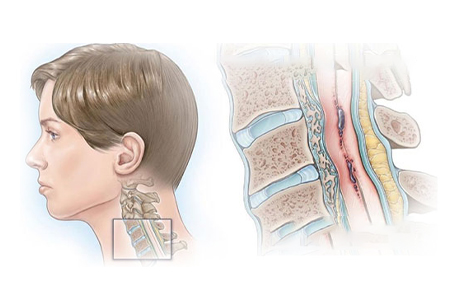
Cervical Spondylotic Myelopathy
Cervical myelopathy is a condition involving compression of the spinal cord at the cervical level of the spinal column resulting in spasticity, hyperreflexia, pathologic reflexes, digit/hand clumsiness, and/or gait disturbance. Any space-occupying lesion within the cervical spine with the potential to compress the spinal cord can cause cervical myelopathy. Cervical myelopathy is predominantly due to pressure on the anterior spinal cord with ischemia as a result of deformation of the cord by anterior herniated discs, spondylitic bone spurs, an ossified posterior longitudinal ligament or spinal stenosis.
Etiology :
- Static factors: A narrowing of the spinal canal size commonly results from degenerative changes in the cervical spine anatomy (cervical spondylosis) such as disc degeneration, spondylosis, stenosis, osteophyte formation at the level of facet joints, segmental ossification of the posterior longitudinal ligament and yellow ligament hypertrophy, calcification or ossification. Patients with a congenitally narrow spinal canal (<13mm) have a higher risk for the development of symptomatic cervical myelopathy. Chronic cervical degeneration is the most common cause of progressive spinal cord and nerve root compression. Spondylotic changes can result in stenosis of the spinal canal, lateral recess, and foramina. Spinal canal stenosis can lead to myelopathy, whereas the latter two can lead to radiculopathy.
- Dynamic factors: Due to mechanical abnormalities of the cervical spine or instability.
- Vascular and cellular factors: Spinal cord ischemia affects oligodendrocytes, which results in demyelination exhibiting features of chronic degenerative disorders. Glutamatergic toxicity, cell injury, and apoptosis may also occur.
Signs And Symptoms :
- Wide-based spastic gait with clumsy upper extremity function
- Numb, clumsy, painful hands, disturbance of fine motor skills
- Distal weakness
- Decreased ROM in the cervical spine, especially extension
- Clumsy or weak hands with difficulty in fine motor movements
- Pain in shoulder or arms
- Unsteady or clumsy gait
- Increased reflexes in the lower extremities and in the upper extremities below the level of the lesion
- Numbness and paresthesia in one or both hands
- Radiculopathy signs
Treatments :
- Abhyanga
- Svedana
- Mridu virechana
- Shastikashali pinda svedana
- Mridu Basti (Mustadiyapana basti)

